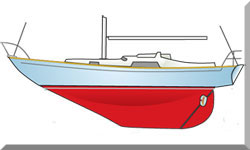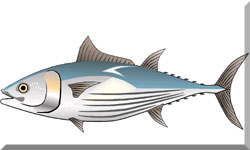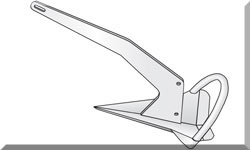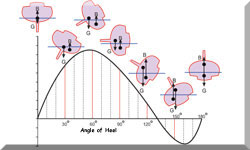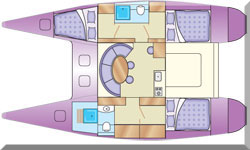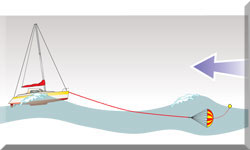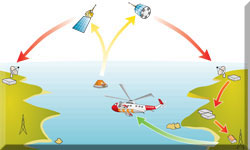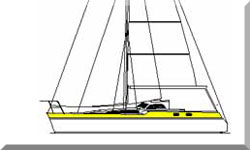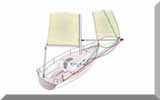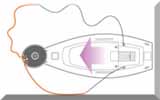- Home
- Parts of a Sailboat
- Warwick Tandem Keel
The Warwick Tandem Keel: A Game-Changer for Recreational Sailors?
Could Two Foils Be Better Than One for Your Next Cruising Yacht?
For us recreational sailors and boat owners, finding that perfect keel often feels like an endless tightrope walk. We crave stability and fantastic pointing ability when heading upwind, but then we also dream of a shallow draft to sneak into those idyllic, hidden anchorages.
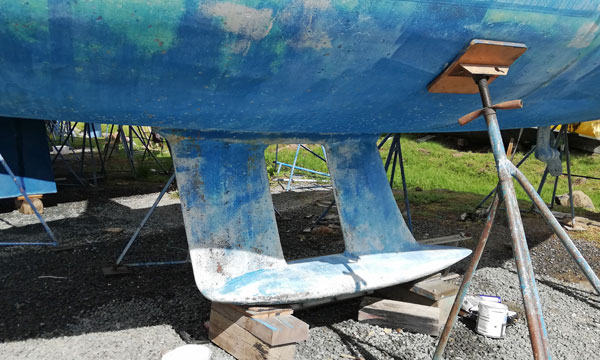 The Warwick Tandem Keel
The Warwick Tandem KeelTraditionally, this has meant compromise: either deep fin keels for raw performance, or shoal keels and wing keels for easier access, each coming with its own set of trade-offs. But what if a design could offer the best of both worlds, and then some? Say hello to the Warwick Tandem Keel.
Developed by yacht designer Warwick Collins, the Warwick Tandem Keel is a unique and rather intriguing innovation that’s been quietly making waves in certain sailing circles. Unlike conventional single-foil keels, the tandem design features two distinct foils, one positioned ahead of the other, working in concert to generate lift and lateral resistance.
How Does the Warwick Tandem Keel Work?
At first glance, the idea might seem a bit odd – why two keels when one has always done the job? The real brilliance of the Warwick Tandem Keel lies in the hydrodynamic interaction between those two foils. The forward foil, typically shorter and deeper, acts as the primary lift generator. The aft foil, usually shallower and longer, then operates in the disturbed water created by the forward foil, effectively "recovering" energy and significantly contributing to overall lift and directional stability.
Imagine an aircraft wing with a flap, but instead of adjusting the flap, you've got two fixed foils, each optimized for a specific role. This synergistic relationship delivers several compelling advantages, making it a compelling sailboat keel design:
- Exceptional Upwind Performance: Generating significant lift with a reduced wetted surface area, the Warwick Tandem Keel translates directly into impressive pointing ability and less leeway when sailing to windward. This means more efficient sailing and fewer tacks to reach your destination.
- Reduced Draft for Enhanced Access: Here's a huge bonus for cruisers: despite its performance chops, the Warwick Tandem Keel can be designed with a surprisingly shallow overall draft compared to a single fin keel offering similar upwind performance. This opens up a wider range of anchorages and cruising grounds that might otherwise be off-limits for a typical cruising yacht keel.
- Improved Stability: Spreading the keel area across two foils can actually lead to increased initial stability, providing a more comfortable ride in choppier seas. That's certainly appealing for anyone prioritizing comfort and safety on board.
- Enhanced Maneuverability (Potentially): While anecdotal, some sailors report that the tandem keel can even contribute to better low-speed maneuverability, especially in tight quarters, thanks to the effective distribution of lateral resistance.
Boats Fitted with the Warwick Tandem Keel
The Warwick Tandem Keel has primarily appeared on a select number of production cruising yachts, often offered as an alternative to a traditional fin or shoal keel. Some notable examples include:
- Westerly Warwick: This boat, designed by Laurent Giles in conjunction with Warwick Collins himself, is perhaps the most obvious example. It was specifically conceived around the Warwick Tandem Keel concept from the very beginning.
- Etap Yachts: The Belgian builder Etap, famed for their "unsinkable" double-skinned hulls, incorporated variations of the tandem keel on some models, like the Etap 30i. This was frequently a shallow-draft option, perfectly complementing their emphasis on safety and comfortable cruising.
- Sadler Yachts: While less common than their popular fin or twin-keel versions, certain Sadler 34s were indeed fitted with Warwick Collins-designed tandem keels.
- Bavaria Cruisers: You might also find a tandem keel offered as an option on specific Bavaria cruising yacht models, such as the Bavaria 30 Cruiser. These often featured a bulb at the bottom of the two vertical sections, further concentrating ballast.
It's worth noting that even on these boats, the tandem keel was usually an option, not the standard fitment, highlighting its niche appeal rather than widespread adoption.
Why Isn't the Warwick Tandem Keel More Popular?
Despite its theoretical and often proven advantages, the Warwick Tandem Keel hasn't become a dominant keel type for several reasons:
Complexity and Cost of Manufacturing:
- Precision Engineering: Designing and building a Warwick Tandem Keel demands a higher degree of precision and more specialized tooling than a simple fin keel. The precise interaction between the two foils is crucial; even small deviations in shape or alignment could negate the benefits.
- Moulding and Layup: Creating the moulds and laying up the GRP (or other composite) for two distinct foils with a precise gap, often involving a connecting bulb or endplate, adds significant complexity and time to the construction process. This directly translates to higher manufacturing costs for the builder.
- Attachment to the Hull: The structural forces exerted on two separate foils, even when connected, necessitate robust and meticulously engineered attachment points to the hull. This can be much more intricate than a single keel stub.
Perceived (and Actual) Disadvantages:
- Antifouling Headache: Applying antifouling between the two foils can be a bit of a nuisance. Not a showstopper, but definitely an added practical consideration for owners.
- Grounding Concerns: While some proponents suggest the design can be quite robust in grounding situations, the presence of two foils, particularly if they have connecting bulbs, might present different challenges if the boat settles on uneven ground compared to a single, deep fin.
- Drag in Light Airs / Wetted Surface Area: Despite aiming for high lift-to-drag, some critics argue that the combined wetted surface area of two foils could lead to slightly higher drag in very light wind conditions compared to a perfectly optimized single fin keel.
- Repair Complexity: In the unfortunate event of a hard grounding or collision, repairing two distinct keel foils, especially if the connecting structure is damaged, could prove more complex and costly than fixing a single keel.
Market Inertia and Traditionalism:
- "If it ain't broke...": For decades, fin keels and, to a lesser extent, bilge/twin keels have served recreational sailors perfectly well. The yachting industry has a strong tradition and a certain degree of conservatism. Many builders and buyers simply stick with what's known and proven.
- Cost vs. Perceived Benefit: For many recreational sailors, the incremental performance increase might not justify the added complexity and potential cost compared to a well-designed conventional shallow fin keel.
Is the Warwick Tandem Keel Right for You?
The Warwick Tandem Keel, while not universally adopted, is a fascinating and often effective alternative in sailboat design. It's a concept that particularly appeals to:
- Cruisers who value performance: If you love to cruise but still enjoy the thrill of a boat that performs well and sails efficiently upwind, the tandem keel could be a strong contender.
- Sailors in shoal-draft areas: For those who frequently navigate shallow waters, the reduced draft without significant performance compromise is a major draw. This makes it a great choice for shallow draft sailboat performance.
- Owners looking for a unique and efficient design: The tandem keel represents a genuine departure from conventional thinking and offers a distinct advantage for those seeking something a bit different.
Things to Consider:
While the advantages of the Warwick Tandem Keel are quite compelling, it's also important to bear a few points in mind:
- Not Suitable for Retrofitting: The Warwick Tandem Keel is a fundamental part of a boat's hull design and demands specific structural integration. It is not a keel that can be easily or practically retrofitted to an existing sailboat. If you're interested in the benefits of a tandem keel, you'll generally need to seek out boats specifically designed and built with this configuration from the outset.
- Fouling: Like any keel, the tandem design can be susceptible to fouling, though the two distinct foils might require slightly different cleaning approaches.
The Future of Keel Design?
The Warwick Tandem Keel, though certainly not ubiquitous, represents an intriguing and effective alternative in sailboat design. For recreational sailors looking to optimize their boat's performance while simultaneously gaining greater access to shallow waters, it offers a truly compelling solution. As the demand for versatile and efficient sailboats continues to grow, innovative designs like the tandem keel might very well become more commonplace, truly pushing the boundaries of what we expect from our beloved sailing vessels.
Recent Articles
-
Heavy Displacement Hulls vs. Light: Choosing Your Offshore Cruiser
Oct 01, 25 04:57 AM
As an experienced sailor, I break down the trade-offs of heavy displacement hulls for comfort, speed, and handling in ocean cruising. -
Designing the Perfect Sailboat Cockpit: A Guide for Sailors
Sep 30, 25 04:44 AM
An experienced sailor's guide to the perfect sailboat cockpit design. We cover ergonomics, safety, and must-have features for offshore sailing. -
Aft vs Centre Cockpit: Which Sailboat is Right for You?
Sep 29, 25 06:43 PM
Choosing a centre cockpit sailboat or an aft cockpit one? Our guide helps you decide by weighing the pros & cons of each for blue water cruising.


